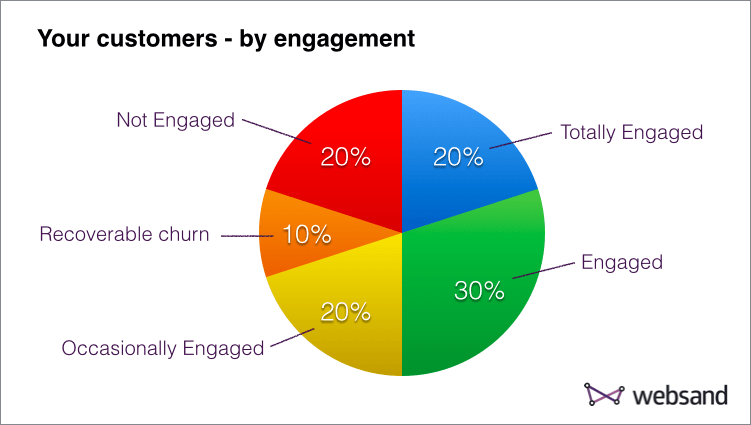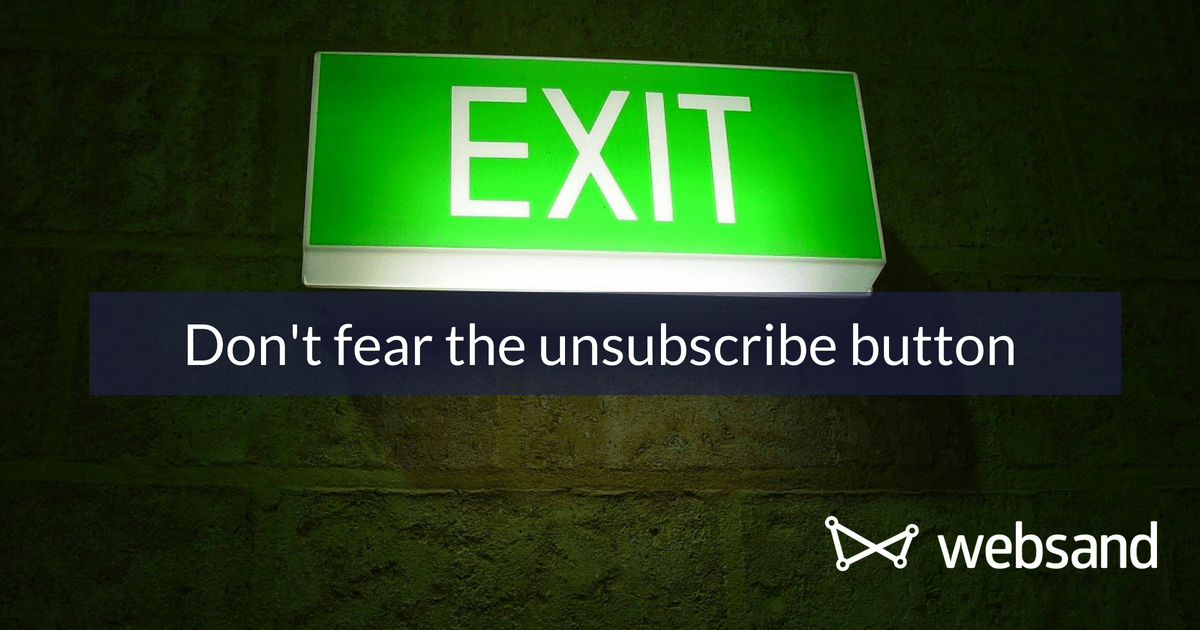Don’t fear the unsubscribe.
As a marketer it’s easy to fear the unsubscribe link. But don’t worry, it’s not the number of people that have signed up for your email marketing that’s important. It’s always been the number of customers that actually ‘give a damn’ that count.
The size of your audience really doesn’t matter, it’s those customers that create the value that you need to focus on. And in the new age of GDPR that is more important than ever.
The doors are there to keep people out, not keep people in.
That is one of my dad’s favourite sayings and it applies for your customer base too.
At Websand, we operate a ‘death star’ unsubscribe policy on behalf of our clients. That means if you hit the unsubscribe button, you are out.
In our opinion that should be the deal.
Unsubscribe should be a binary question. Are you in or are you out.
It’s a growing trend to asking customers or prospects to select which group they want to unsubscribe from.
“I’d love to receive news on pancakes, but please don’t send me anything about maple syrup.”
I’d suggest that policies ask you to select what you don’t want to receive at the point of unsubscribe just add more confusion to the customer.
I understand why this a popular thing to ask, it’s hard to let go, however, if you are communicating in a respectful and relevant way, then it should not be an issue.
If you believe it really is important to your business (and it might be really important), then ask the people on the way into your business, rather than on the way out.
And that’s when you can start creating some really clever communication. Want proof it works, read this!
If you want out, then PLEASE hit unsubscribe.
When a customer unsubscribes, they you are telling you (the marketer) that they aren’t interested anymore. It’s over.
What a gift of clarity, I’d suggest that is something to be embraced.
So your unsubscribe should be a clear, a call to action.
Some people are pushing for unsubscribe to be included in the header of the email. If you think that will work for you, then give it a try.
We make it a key part of our marketing communications and we put it at the footer – not as a call to action, but because that is where people expect to find the unsubscribe within an email.
See this great example of an unsubscribe from ‘The Hustle’ – a daily newsletter.

It’s ok if they don’t want to receive marketing communications anymore.
As part of the process of unsubscribing, that customer or prospect will have seen at least one of your marketing messages, they will have read it and decided it’s not for them.
That is something to be celebrated. It’s a GOOD thing.
It means you can focus all of your time and effort into communicating and sending really clever and engaging emails to those customers that WANT to receive information, news and offers about your business.
Respecting people’s privacy
Data protection legislation is a hot topic both here in Europe and the US. Data breaches are big news, look at the recent Ticketmaster hack, as well as the Carphone Warehouse and the Cambridge Analytica incidents.
So it’s more important than ever to focus on sending engaging marketing messages to people that want to receive information from you.
Privacy is now regarded as a basic human right. So it’s your duty as a marketer to respect it.
If people aren’t engaged after a specific period of time, then perhaps you aren’t for them and it’s time to move on.
Of course we are referring to everyone’s favourite topic, GDPR. For more info on GDPR, check out our GDPR functionality or book a free chat with our friends at GDPRworkflow.
It’s not you Mr Customer, it’s me!
It’s human nature to try and win the hearts and minds of those people that aren’t interested.
“I can make them change!”, “I can convince them”.
If they have bought from you in the past, and within a specific time frame you have a decent chance of winning them back – see our posts on increasing customer retention for more on that.
However, if they have never bought from you and are apathetic to your marketing messages (never open anything), then perhaps it’s time to accept that they just aren’t into your product or service.
Better results with focused engagement
Websand helps you to easily identify those customers that ARE engaged and those that ARE NOT.
So you can focus on those people that ARE engaged and add value to your business.
The chart below gives a typical breakdown of customer ‘engagement’ within an e-commerce business.

Based on the above ‘engagement’ then likelihood is you’ll have…
- Awesome engagement with around 20% of your customers.
- Reasonable engagement from about 30%,
- The next 30% go either way,
- Whereas 20% have left the building but you didn’t notice (or didn’t care).
So apply focus to those customers that you are engaged with. Use this as a starting point for customer segmentation, and the outcomes will be significant.
For a start, you have a clear understanding of how many active customers you really have. It’s quality not quantity that counts.
You are sending messages to a more engaged audience. A targeted higher quality audience, so naturally your response rates increase, and that will be very well received indeed.
You can be more focused in your marketing. With have clarity on who your customers really are, what they buy and how they react to your marketing messages.
And that’s when you can start creating some really clever communication. Want proof it works, read this!
Manage your customer data and increase engagement.
It’s really that simple, sign up or book a call and we’ll show you how.
It’s time to start getting more from your email marketing
Sign up for a free Websand demo and let’s show you how to get the best from your email marketing.
